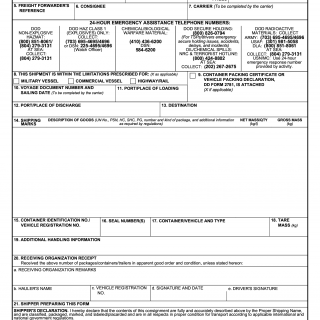DD Form 2890. DoD Multimodal Dangerous Goods Declaration
DD Form 2890, also known as the DoD Multimodal Dangerous Goods Declaration, is a form used by the United States Department of Defense to declare dangerous goods that are being transported by air, sea, or ground.
The main purpose of this form is to ensure that dangerous goods are properly declared and packaged for transportation, in compliance with national and international regulations. The form consists of several parts, including the shipment information, the dangerous goods information, and the certification.
Important fields to consider when completing this form include the proper identification of the dangerous goods being transported, the quantity, the proper packaging and labeling, and the contact information for the shipper and consignee.
Parties involved in this process include the shipper, the carrier, and the consignee, as well as any regulatory agencies responsible for overseeing the transportation of dangerous goods.
Data required when completing this form includes the proper identification of the dangerous goods being transported, the quantity, the proper packaging and labeling, and the contact information for the shipper and consignee. Additional documents that must be attached include the Material Safety Data Sheet (MSDS) and any other relevant documentation, such as permits or licenses.
Practice and use cases for this form include the transportation of hazardous materials by the Department of Defense, such as explosives, flammable liquids, and radioactive materials. This form is also used by contractors who are transporting dangerous goods on behalf of the Department of Defense.
Strengths of this form include its compliance with national and international regulations and its ability to ensure the safe transportation of dangerous goods. Weaknesses may include the potential for errors or omissions if the shipper is not properly trained or does not have access to the necessary information.
Opportunities for this form include the ability to promote the safe and secure transportation of dangerous goods, while threats may include the potential for accidents or incidents that could cause harm to individuals or the environment.
Related forms and analogues include the IATA Dangerous Goods Declaration, which is used for the transportation of dangerous goods by air, and the IMO Dangerous Goods Declaration, which is used for the transportation of dangerous goods by sea. The main difference between these forms and the DD Form 2890 is the specific regulations and requirements that apply to each mode of transportation.
The form affects the future of the participants by ensuring that they are in compliance with national and international regulations for the transportation of dangerous goods, which can help to prevent accidents and incidents. The form is typically submitted electronically or in paper form to the appropriate regulatory agency, and is stored in a database for reference and review.

